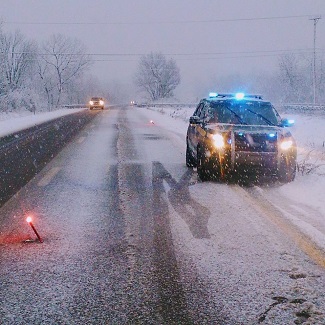 Winter driving calls for extra caution, with more snow and ice to deal with, and less daylight. Stay safe out there with these annual winter driving reminders.
Winter driving calls for extra caution, with more snow and ice to deal with, and less daylight. Stay safe out there with these annual winter driving reminders.
Ahead of Time
- Practice handling your vehicle on ice and snow in an empty parking lot.
- Make sure brakes, wipers, defroster, heater and exhaust system are in top condition.
- Check that antifreeze and windshield washer fluid are ready for colder temperatures.
- Put good winter or snow tires (the same type) on all four wheels, and be sure they are properly inflated with sufficient tread depth.
- Add winter items to your emergency kit: ice scraper/snow brush, shovel, non-clumping kitty litter or sand, warm clothing and boots, food and water, windshield washer fluid, candle and matches, blanket, non-freeze cleaner and paper towels to clean windshield and lights.
- Keep the gas tank at least half full.
- For the latest information on road conditions, dial 511 or check www.511vt.com.
- Remember your cellphone, but don't become overly dependent on the device; remember there are poor coverage areas.
- Clear all snow and ice from windows, mirrors, lights, wipers, hood, trunk and roof.
On the Road
- Watch out for ice, especially on bridges, ramps, and overpasses.
- Slow down, minimize distractions and increase following distance to more than four seconds. Four- and all-wheel drive vehicles have better traction in snow, but not on ice. Be wary of over-confidence.
- Do use headlights. Don’t use cruise control.
- Be extra careful near snowplows, never try to pass on the right or when the snow cloud prevents you from seeing clearly, and allow plenty of room.
- Travel in daylight on main roads, don’t go alone, and let others know your route and schedule.
- To avoid skidding, take it slow and don’t make sudden changes in speed or direction. To slow down with control, take your foot off the gas. If you need brakes, squeeze the pedal with slow, steady pressure. Don’t pump anti-lock brakes, or remove your foot from the pedal when they vibrate.
- To recover from a skid, steer in the direction you want the vehicle to go, correcting as needed to the right and left until you’ve restored control.
If you’re stranded:
- Activate four-way flashers and call for help if you can.
- Remain in your vehicle. Don’t leave unless you see shelter nearby, and be careful: Distances can be deceiving, especially in deep snow.
- In the unlikely event you might be stranded for some time, run the engine and heater for about 10 minutes each hour for warmth. Open a downwind window slightly while the engine is running, and keep snow clear from the exhaust pipe. Turn on the interior light at night for visibility.
- Try not to waste battery power. Balance the need for lights, heat, and radio with supply.

